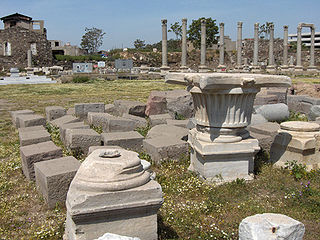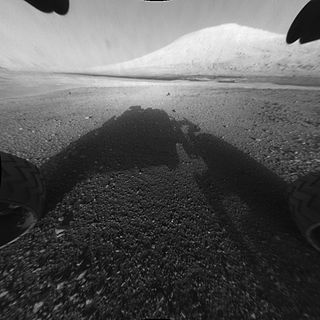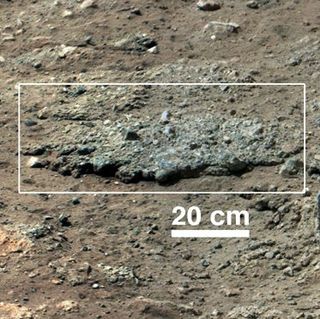Related Research Articles

The Aeolians were one of the four major tribes in which Greeks divided themselves in the ancient period. They originated in the eastern parts of the Greek mainland, notably in Thessaly and Boeotia. By c. 1100 BC, the Aeolians began their early settlements on the west coast of Anatolia, known as Aeolis, comprising the territory between Troas and Ionia, as well as on the Aegean islands of Lesbos and Tenedos. A second round of Aeolian settlements took place during the 7th century. They spoke Aeolic, a dialect of Ancient Greek most famously known for its use by poets like Sappho and Alcaeus from Lesbos, and Corinna from Boeotia.

Aeolis, or Aeolia, was an area that comprised the west and northwestern region of Asia Minor, mostly along the coast, and also several offshore islands, where the Aeolian Greek city-states were located. Aeolis incorporated the southern parts of Mysia, and is bounded by it to the north, Ionia to the south, and Lydia to the east.

Cyme or Cumae was an Aeolian city in Aeolis close to the kingdom of Lydia. It was called Phriconian, perhaps from the mountain Phricion in Aeolis, near which the Aeolians had been settled before their migration to Asia.

Gale is a crater, and probable dry lake, at 5.4°S 137.8°E in the northwestern part of the Aeolis quadrangle on Mars. It is 154 km (96 mi) in diameter and estimated to be about 3.5–3.8 billion years old. The crater was named after Walter Frederick Gale, an amateur astronomer from Sydney, Australia, who observed Mars in the late 19th century. Mount Sharp is a mountain in the center of Gale and rises 5.5 km (18,000 ft) high. Aeolis Palus is the plain between the northern wall of Gale and the northern foothills of Aeolis Mons. Peace Vallis, a nearby outflow channel, 'flows' down from the hills to the Aeolis Palus below and seems to have been carved by flowing water. Several lines of evidence suggest that a lake existed inside Gale shortly after the formation of the crater.

Aeolis Mensae is a tableland feature in the northwest Aeolis quadrangle of Mars. Its location is centered at 2.9° south latitude and 219.6° west longitude, in the transition zone between the Martian highlands and lowlands. It is 820 kilometres (510 mi) long and was named after a classical albedo feature (Aeolis). The constituent mensae can be as long as 70 kilometres (43 mi) and as tall as 2 kilometres (1.2 mi). It is notable for being the origin of an abnormal concentration of methane detected by Curiosity in 2019, although its geology has attracted scientific attention since at least a decade before this event. Aeolis Mensae is also the first region in Mars where submarine cyclic steps, an erosion feature that gives evidence of an ancient ocean, were identified.

Mount Sharp, officially Aeolis Mons, is a mountain on Mars. It forms the central peak within Gale crater and is located around 5.08°S 137.85°E, rising 5.5 km (18,000 ft) high from the valley floor. Its ID in the United States Geological Survey's Gazetteer of Planetary Nomenclature is 15000.

Aeolis Palus is a plain between the northern wall of Gale crater and the northern foothills of Aeolis Mons on Mars. It is located at 4.47°S 137.42°E.

Peace Vallis is an ancient stream valley on the northern rim of Gale Crater on the planet Mars. It is notable for its associated alluvial fan which lies near the Mars Science Laboratory Curiosity landing site. The valley and alluvial fan provide evidence for geologically recent (Amazonian-aged) fluvial activity and sustained water flow on Mars. Recent high-resolution orbital images of Peace Vallis and its watershed also suggest that at least one glacial episode affected Gale crater. All of this evidence has implications for the history of water on Mars and the planet's long-term habitability. Understanding Peace Vallis and its fan also provides geologic context for the rocks observed on the ground by the Curiosity rover.

Bathurst Inlet is a rock on the surface of Aeolis Palus, between Peace Vallis and Aeolis Mons, in Gale crater on the planet Mars. The rock was encountered by the Curiosity rover on the way from Bradbury Landing to Glenelg Intrigue on September 30, 2012 and was named after Bathurst Inlet, a deep inlet located along the northern coast of the Canadian mainland. The "approximate" site coordinates are: 4.59°S 137.44°E.

Hottah is a rock outcrop on the surface of Aeolis Palus, between Peace Vallis and Aeolis Mons, in Gale crater on the planet Mars.

Link is a rock outcrop on the surface of Aeolis Palus, between Peace Vallis and Aeolis Mons, in Gale crater on the planet Mars. The outcrop was encountered by the Curiosity rover on the way from Bradbury Landing to Glenelg Intrigue on September 2, 2012, and was named after a significant rock formation in the Northwest Territories of Canada. The "approximate" site coordinates are: 4.59°S 137.44°E.

Goulburn, also known as Goulburn Scour, is a rock outcrop on the surface of Aeolis Palus, between Peace Vallis and Aeolis Mons, in Gale crater on the planet Mars. The outcrop was encountered by the Curiosity rover on landing at the Bradbury Landing on August 6, 2012 and is named after a two-billion year-old sequence of rocks in Northern Canada. The "approximate" site coordinates are: 4.59°S 137.44°E.

Rocknest 3 is a rock on the surface of Aeolis Palus, between Peace Vallis and Aeolis Mons, in Gale crater on the planet Mars. The approximate site coordinates are: 4.59°S 137.44°E.

Tintina is a rock on the surface of Aeolis Palus, between Peace Vallis and Aeolis Mons, in Gale crater on the planet Mars. The approximate site coordinates are: 4.59°S 137.44°E.
Listrocerum is a genus of longhorn beetles of the subfamily Lamiinae, containing the following species:
Listrocerum fuscopicalis is a species of beetle in the family Cerambycidae. It was described by Stephan von Breuning in 1961. It is known from Cameroon.
Nasos was a town and polis (city-state) of ancient Aeolis. The place-name "Nesos Pordoselene" appears in the list of tributes to ancient Athens of the year 422/1 BC but there are different opinions on whether Nesos and Pordoselene were a single city or if they are two different cities. On the other hand, the nickname "nasiotas" (Νασιώτας) appears in an inscription of Adramyttium dated to 319-317 BC.
Melampagos was a town of ancient Aeolis. It is evidenced by epigraphic evidence dated to the 5th century BCE on decrees establishing boundaries between Melampagos and Heraclea.
Tisna, also known as Titne (Τιτνη), was a town of ancient Aeolis. It is known from numismatic evidence, specifically bronze coins of the 4th century BCE inscribed «ΤΙΣΝΑΙ», «ΤΙΣΝΑΙΟ», «ΤΙΣΝΑΙΟΣ» or «ΤΙΣΝΑΙΟΝ» that are attributed to the city. It is assumed that the city took its name from the river Tisna, whose personification appears on the coins.
References
- ↑ BioLib.cz - Listrocerum aeolis. Retrieved on 8 September 2014.